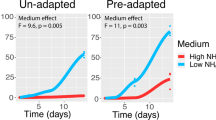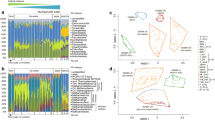Abstract
Spatial separation of metabolic stages in anaerobic digesters can increase the methane content of biogas, as realized in a tube anaerobic baffled reactor. Here, we investigated the performance and microbial community dynamics of a laboratory-scale mesophilic anaerobic baffled reactor with four compartments treating an artificial substrate. Due to the activity of fermentative bacteria, organic acids mostly accumulated in the initial compartments. The methane content of the biogas increased while hydrogen levels decreased along the compartments. Microbial communities were investigated based on bacterial 16S rRNA genes, hydA genes encoding Fe–Fe-hydrogenases, and mcrA genes/transcripts encoding the methyl-CoM reductase. The metaproteome was analyzed to identify active metabolic pathways. During the reactor operation, Clostridia and Bacilli became most abundant in the first compartment. Later compartments were dominated by Sphingobacteriia, Deltaproteobacteria, Clostridia, Bacteroidia, Synergistia, Anaerolineae, Spirochaetes, vadinHA17, and W5 classes. Methanogenic communities were represented by Methanomicrobiales, Methanobacteriaceae, Methanosaeta, and Methanosarcina in the last compartments. Analysis of hydA and mcrA genes and metaproteome data confirmed the spatial separation of metabolic stages. In the first compartment, proteins of carbohydrate transport and metabolism were most abundant. Proteins assigned to coenzyme metabolism and transport as well as energy conservation dominated in the other compartments. Our study demonstrates how the spatial separation of metabolic stages by reactor design is underpinned by the adaptation of the microbial community to different niches.








Similar content being viewed by others
Explore related subjects
Discover the latest articles and news from researchers in related subjects, suggested using machine learning.References
Abdo Z, Schütte UM, Bent SJ, Williams CJ, Forney LJ, Joyce P (2006) Statistical methods for characterizing diversity of microbial communities by analysis of terminal restriction fragment length polymorphisms of 16S rRNA genes. Environ Microbiol 8:929–938. https://doi.org/10.1111/j.1462-2920.2005.00959.x
Abram F, Enright AM, O'Reilly J, Botting CH, Collins G, O'Flaherty V (2011) A metaproteomic approach gives functional insights into anaerobic digestion. J Appl Microbiol 110:1550–1560. https://doi.org/10.1111/j.1365-2672.2011.05011.x
Bachmann A, Beard VL, McCarty PL (1985) Performance characteristics of the anaerobic baffled reactor. Water Res 19:99–106. https://doi.org/10.1016/0043-1354(85)90330-6
Ban Q, Li J, Zhang L, Jha AK, Nies L (2013) Linking performance with microbial community characteristics in an anaerobic baffled reactor. Appl Biochem Biotechnol 169:1822–1836. https://doi.org/10.1007/s12010-013-0105-6
Cabezas A, Calabria de Araujo J, Callejas C, Galès A, Hamelin J, Marone A, Sousa DZ, Trably E, Etchebehere C (2015) How to use molecular biology tools for the study of the anaerobic digestion process? Rev Environ Sci Biotechnol 14:555–593. https://doi.org/10.1007/s11157-015-9380-8
Caporaso JG, Kuczynski J, Stombaugh J, Bittinger K, Bushman FD, Costello EK, Fierer N, Pena AG, Goodrich JK, Gordon JI (2010) QIIME allows analysis of high-throughput community sequencing data. Nat Methods 7:335–336. https://doi.org/10.1038/nmeth.f.303
Chen S, Cheng H, Liu J, Hazen TC, Huang V, He Q (2017) Unexpected competitiveness of Methanosaeta populations at elevated acetate concentrations in methanogenic treatment of animal wastewater. Appl Microbiol Biotechnol 101:1729–1738. https://doi.org/10.1007/s00253-016-7967-9
Chung KT (1976) Inhibitory effects of H2 on growth of Clostridium cellobioparum. Appl Environ Microbiol 31:342–348
Conklin A, Stensel HD, Ferguson J (2006) Growth kinetics and competition between Methanosarcina and Methanosaeta in mesophilic anaerobic digestion. Water Environ Res 78:486–496. https://doi.org/10.2175/106143006X95393
Dahle H, Birkeland NK (2006) Thermovirga lienii gen. nov., sp. nov., a novel moderately thermophilic, anaerobic, amino-acid-degrading bacterium isolated from a North Sea oil well. Int J Syst Evol Microbiol 56:1539–1545. https://doi.org/10.1099/ijs.0.63894-0
Gänzle MG, Follador R (2012) Metabolism of oligosaccharides and starch in lactobacilli: a review. Front Microbiol 3:340. https://doi.org/10.3389/fmicb.2012.00340
Gulhane M, Pandit P, Khardenavis A, Singh D, Purohit H (2017) Study of microbial community plasticity for anaerobic digestion of vegetable waste in anaerobic baffled reactor. Renew Energy 101:59–66. https://doi.org/10.1016/j.renene.2016.08.021
Haange SB, Oberbach A, Schlichting N, Hugenholtz F, Smidt H, von Bergen M, Till H, Seifert J (2012) Metaproteome analysis and molecular genetics of rat intestinal microbiota reveals section and localization resolved species distribution and enzymatic functionalities. J Proteome Res 11:5406–5417. https://doi.org/10.1021/pr3006364
Heyer R, Benndorf D, Kohrs F, De Vrieze J, Boon N, Hoffmann M, Rapp E, Schlüter A, Sczyrba A, Reichl U (2016) Proteotyping of biogas plant microbiomes separates biogas plants according to process temperature and reactor type. Biotechnol Biofuels 9:155. https://doi.org/10.1186/s13068-016-0572-4
Heyer R, Kohrs F, Reichl U, Benndorf D (2015) Metaproteomics of complex microbial communities in biogas plants. Microb Biotechnol 8:749–763. https://doi.org/10.1111/1751-7915.12276
Holm-Nielsen JB, Al Seadi T, Oleskowicz-Popiel P (2009) The future of anaerobic digestion and biogas utilization. Bioresour Technol 100:5478–5484. https://doi.org/10.1016/j.biortech.2008.12.046
Huang Y, Zong W, Yan X, Wang R, Hemme CL, Zhou J, Zhou Z (2010) Succession of the bacterial community and dynamics of hydrogen producers in a hydrogen-producing bioreactor. Appl Environ Microbiol 76:3387–3390. https://doi.org/10.1128/AEM.02444-09
Jehmlich N, Schmidt F, Hartwich M, von Bergen M, Richnow HH, Vogt C (2008) Incorporation of carbon and nitrogen atoms into proteins measured by protein-based stable isotope probing (protein-SIP). Rapid Commun Mass Spectrom 22:2889–2297. https://doi.org/10.1002/rcm.3684
Lan GQ, Ho YW, Abdullah N (2002) Mitsuokella jalaludinii sp. nov., from the rumens of cattle in Malaysia. Int J Syst Evol Microbiol 52:713–718. https://doi.org/10.1099/00207713-52-3-713
Liu Y, Balkwill DL, Aldrich HC, Drake GR, Boone DR (1999) Characterization of the anaerobic propionate-degrading syntrophs Smithella propionica gen. nov., sp. nov. and Syntrophobacter wolinii. Int J Syst Bacteriol 49:545–556. https://doi.org/10.1099/00207713-49-2-545
Lü F, Bize A, Guillot A, Monnet V, Madigou C, Chapleur O, Mazéas L, He P, Bouchez T (2014) Metaproteomics of cellulose methanisation under thermophilic conditions reveals a surprisingly high proteolytic activity. ISME J 8:88–102. https://doi.org/10.1038/ismej.2013.120
Lucas R, Kuchenbuch A, Fetzer I, Harms H, Kleinsteuber S (2015) Long-term monitoring reveals stable and remarkably similar microbial communities in parallel full-scale biogas reactors digesting energy crops. FEMS Microbiol Ecol 91:fiv004. https://doi.org/10.1093/femsec/fiv004
Luton PE, Wayne JM, Sharp RJ, Riley PW (2002) The mcrA gene as an alternative to 16S rRNA in the phylogenetic analysis of methanogen populations in landfill. Microbiology 148:3521–3530. https://doi.org/10.1099/00221287-148-11-3521
McIlroy SJ, Saunders AM, Albertsen M, Nierychlo M, McIlroy B, Hansen AA, Karst SM, Nielsen JL, Nielsen PH (2015) MiDAS: the field guide to the microbes of activated sludge. Database (Oxford) 2015:bav062. https://doi.org/10.1093/database/bav062
McInerney MJ, Bryant MP, Hespell RB, Costerton JW (1981) Syntrophomonas wolfei gen. nov. sp. nov., an anaerobic, syntrophic, fatty acid-oxidizing bacterium. Appl Environ Microbiol 41:1029–1039
Mitsuoka T, Terada A, Watanabe K, Uchida K (1974) Bacteroides multiacidus, a new species from the feces of humans and pigs. Int J Syst Evol Microbiol 24:35–41. https://doi.org/10.1099/00207713-24-1-35
Monserrate E, Leschine SB, Canale-Parola E (2001) Clostridium hungatei sp. nov., a mesophilic, N2-fixing cellulolytic bacterium isolated from soil. Int J Syst Evol Microbiol 51:123–132. https://doi.org/10.1099/00207713-51-1-123
Nikolausz M, Walter RF, Sträuber H, Liebetrau J, Schmidt T, Kleinsteuber S, Bratfisch F, Günther U, Richnow HH (2013) Evaluation of stable isotope fingerprinting techniques for the assessment of the predominant methanogenic pathways in anaerobic digesters. Appl Microbiol Biotechnol 97:2251–2262. https://doi.org/10.1007/s00253-012-4657-0
Nishiyama T, Ueki A, Kaku N, Ueki K (2009) Clostridium sufflavum sp. nov., isolated from a methanogenic reactor treating cattle waste. Int J Syst Evol Microbiol 59:981–986. https://doi.org/10.1099/ijs.0.001719-0
Oksanen J (2011) Multivariate analysis of ecological communities in R: vegan tutorial. Publisher Univ Oulu Comput Serv Cent 83:1–43
Oliveros JC (2007-2015) Venny. An interactive tool for comparing lists with Venn’s diagrams. http://bioinfogp.cnb.csic.es/tools/venny/index.html
Pelletier E, Kreimeyer A, Bocs S, Rouy Z, Gyapay G, Chouari R, Rivière D, Ganesan A, Daegelen P, Sghir A, Cohen GN, Médigue C, Weissenbach J, Le Paslier D (2008) “Candidatus Cloacamonas acidaminovorans”: genome sequence reconstruction provides a first glimpse of a new bacterial division. J Bacteriol 190:2572–2579. https://doi.org/10.1128/JB.01248-07
Plugge CM, Balk M, Zoetendal EG, Stams AJ (2002) Gelria glutamica gen. nov., sp. nov., a thermophilic, obligately syntrophic, glutamate-degrading anaerobe. Int J Syst Evol Microbiol 52:401–407. https://doi.org/10.1099/00207713-52-2-401
Pöschl M, Ward S, Owende P (2010) Evaluation of energy efficiency of various biogas production and utilization pathways. Appl Energy 87:3305–3321. https://doi.org/10.1016/j.apenergy.2010.05.011
Purushe J, Fouts DE, Morrison M, White BA, Mackie RI, North American Consortium for Rumen Bacteria, Coutinho PM, Henrissat B, Nelson KE (2010) Comparative genome analysis of Prevotella ruminicola and Prevotella bryantii: insights into their environmental niche. Microb Ecol 60:721–729. https://doi.org/10.1007/s00248-010-9692-8
Ramandeep K (2016) Anaerobic baffled reactor: a promising wastewater treatment technology in tropical countries. Int J Emerg Technol 7:114–117
Schnürer A, Jarvis Å (2018) Microbiology of the biogas process. ISBN 978-91-576-9546-8
Steinberg LM, Regan JM (2008) Phylogenetic comparison of the methanogenic communities from an acidic, oligotrophic fen and an anaerobic digester treating municipal wastewater sludge. Appl Environ Microbiol 74:6663–6671. https://doi.org/10.1128/AEM.00553-08
Su XL, Tian Q, Zhang J, Yuan XZ, Shi XS, Guo RB, Qiu YL (2014) Acetobacteroides hydrogenigenes gen. nov., sp. nov., an anaerobic hydrogen-producing bacterium in the family Rikenellaceae isolated from a reed swamp. Int J Syst Evol Microbiol 64:2986–2991. https://doi.org/10.1099/ijs.0.063917-0
Takahashi N, Yamada T (2000) Glucose metabolism by Prevotella intermedia and Prevotella nigrescens. Oral Microbiol Immunol 15:188–195. https://doi.org/10.1034/j.1399-302x.2000.150307.x
Tatusov RL, Natale DA, Garkavtsev IV, Tatusova TA, Shankavaram UT, Rao BS, Kiryutin B, Galperin MY, Federova ND, Koonin EV (2001) The COG database: new developments in phylogenetic classification of proteins from complete genomes. Nucleic Acids Res 29:22–28
Taubert M, Jehmlich N, Vogt C, Richnow HH, Schmidt F, von Bergen M, Seifert J (2011) Time resolved protein-based stable isotope probing (protein-SIP) analysis allows quantification of induced proteins in substrate shift experiments. Proteomics 11:2265–2274. https://doi.org/10.1002/pmic.201000788
Vanwonterghem I, Jensen PD, Ho DP, Batstone DJ, Tyson GW (2014) Linking microbial community structure, interactions and function in anaerobic digesters using new molecular techniques. Curr Opin Biotechnol 27:55–64. https://doi.org/10.1016/j.copbio.2013.11.004
Vignais PM, Billoud B, Meyer J (2001) Classification and phylogeny of hydrogenases. FEMS Microbiol Rev 25:455–501. https://doi.org/10.1111/j.1574-6976.2001.tb00587.x
Ward B (2015) Chapter 11 – bacterial energy metabolism. In: Tang YW, Sussman M, Liu D, Poxton I (eds) Molecular medical microbiology, 2nd edn. Elsevier, Volume 1, pp 201–233. https://doi.org/10.1016/B978-0-12-397169-2.00011-1
Wintsche B, Jehmlich N, Popp D, Harms H, Kleinsteuber S (2018) Metabolic adaptation of methanogens in anaerobic digesters upon trace element limitation. Front Microbiol 9:405. https://doi.org/10.3389/fmicb.2018.00405
Xing D, Ren N, Rittmann BE (2008) Genetic diversity of hydrogen-producing bacteria in an acidophilic ethanol-H2-coproducing system, analyzed using the [Fe]-hydrogenase gene. Appl Environ Microbiol 74:1232–1239. https://doi.org/10.1128/AEM.01946-07
Yamada T, Sekiguchi Y, Hanada S, Imachi H, Ohashi A, Harada H, Kamagata Y (2006) Anaerolinea thermolimosa sp. nov., Levilinea saccharolytica gen. nov., sp. nov. and Leptolinea tardivitalis gen. nov., sp. nov., novel filamentous anaerobes, and description of the new classes Anaerolineae classis nov. and Caldilineae classis nov. in the bacterial phylum Chloroflexi. Int J Syst Evol Microbiol 56:1331–1340. https://doi.org/10.1099/ijs.0.64169-0
Ziganshin AM, Liebetrau J, Pröter J, Kleinsteuber S (2013) Microbial community structure and dynamics during anaerobic digestion of various agricultural waste materials. Appl Microbiol Biotechnol 97:5161–5174. https://doi.org/10.1007/s00253-013-4867-0
Ziganshin AM, Schmidt T, Lv Z, Liebetrau J, Richnow HH, Kleinsteuber S, Nikolausz M (2016a) Reduction of the hydraulic retention time at constant high organic loading rate to reach the microbial limits of anaerobic digestion in various reactor systems. Bioresour Technol 217:62–71. https://doi.org/10.1016/j.biortech.2016.01.096
Ziganshin AM, Ziganshina EE, Kleinsteuber S, Nikolausz M (2016b) Comparative analysis of methanogenic communities in different laboratory-scale anaerobic digesters. Archaea 2016(3401272):12. https://doi.org/10.1155/2016/3401272
Acknowledgments
The authors wish to thank Ute Lohse for technical support in amplicon sequencing.
Funding
This study was funded by the Russian Foundation for Basic Research (Grant No. 16-34-60093 mol_a_dk and Grant No. 18-29-25058 awarded to AMZ).
Author information
Authors and Affiliations
Corresponding author
Ethics declarations
Conflict of interest
The authors declare that they have no conflict of interest.
Ethical approval
This article does not contain any studies with human participants or animals performed by any of the authors.
Additional information
Publisher’s note
Springer Nature remains neutral with regard to jurisdictional claims in published maps and institutional affiliations.
Rights and permissions
About this article
Cite this article
Ziganshin, A.M., Wintsche, B., Seifert, J. et al. Spatial separation of metabolic stages in a tube anaerobic baffled reactor: reactor performance and microbial community dynamics. Appl Microbiol Biotechnol 103, 3915–3929 (2019). https://doi.org/10.1007/s00253-019-09767-2
Received:
Revised:
Accepted:
Published:
Issue Date:
DOI: https://doi.org/10.1007/s00253-019-09767-2
Keywords
Profiles
- Sabine Kleinsteuber View author profile




